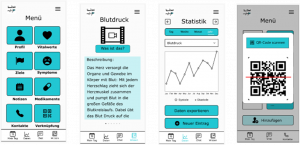Active patient participation: App guided, and healthcare expert supported clinical hypertension self-management
Aim and Research Question(s)
The aim of this study was to design, develop and evaluate an interactive clickable application prototype to promote self-management in patients with diagnosed arterial hypertension in clinical setting using an adapted user-centred design method. Research questions: (1) What are the functional requirements of an application for the promotion of self-management by supported self-monitoring and hypertension management in the clinical setting? (2) How do health professionals' and hypertension patients’ current experiences in using digital health apps for blood pressure management show up in self-assessment?
Background
Hypertension affects around 1.278 billion people worldwide [1] and causes serious health consequences. Related to the strong interaction with hypertensive patients in hospitals [2] and the evidenced potential of ICT's in the blood pressure management [3], a clinical hypertension application could support those affected in acquiring self-monitoring and hypertension management skills through an expert-guided app-usage.
Methods
Adopted UCD process: (1) Analysis - Literature and market research, two online questionnaires, (2) Defining requirements, (3) Design - Hand drawn scribbles, (4) Refining requirements - Focus group interview with four registered nurses, (5) Conception - Prototype conducted with Adobe XD, (6) Evaluation - Feasibility test and UX questionnaire
Results and Discussion
The awareness of hypertension apps is low in nurses as well as hypertension patients. Although 80% of the nurses and 50% of the hypertension patients would be open to use such an application. The defined requirements resulted in the prototype “How2beat”. Thereby the requirements defined by the nurses and hypertension patients didn’t differ much from those found in the literature. Except for efficiency, all categories of the UX questionnaire were rated well. Some design aspects were mentioned as confusing, due to the limited functionality of the prototype. The general concept of the application was seen positively. Discussion: Although 90% of the nurses weren’t aware of hypertension apps, they rated themselves as having satisfactory skills in the usage of digital health apps due to the common clinical usage in other health concerns [4]. The low openness of hypertension patients to use a hypertension application was also found by two studies [5][6]. The reason for the outcomes could be referred to the age of the participating hypertension patients (mean=60.2 years).
Limitations: Unequal testing conditions could have influenced the outcome of the feasibility test and UX questionnaire. Furthermore, no evaluation with the actual target group was conducted.
Discussion: Although 90% of the nurses weren’t aware of hypertension apps, they rated themselves as having satisfactory skills in the usage of digital health apps due to the common clinical usage in other health concerns [4]. The low openness of hypertension patients to use a hypertension application was also found by two studies [5][6]. The reason for the outcomes could be referred to the age of the participating hypertension patients (mean=60.2 years).
Limitations: Unequal testing conditions could have influenced the outcome of the feasibility test and UX questionnaire. Furthermore, no evaluation with the actual target group was conducted.
Conclusion
The next step would be to adapt the prototype to the evaluation-results and testing the prototype with the actual target group under equal test conditions. Furthermore, the prototype should be implemented as a running application. If taking further application areas into account, this digital health approach could also be extended to the extramural setting and home care.
References
[1] B. Zhou et al., The Lancet, 398:957–980, 2021. [2] T.S. Anderson et al., JAMA Internal Medicine, 179(11):1528-1536, 2019. [3] R.J. McManus et al., BMJ, 372: 4858-4871, 2021.[4] U.Kramer et al., HealthOn, 11:118, 2016.[5] Vo et al., JMIR MHealth, 7:e13817, 2019.[6] Morrissey et. al., Patient Preference and Adherence, 12: 813-822, 2018